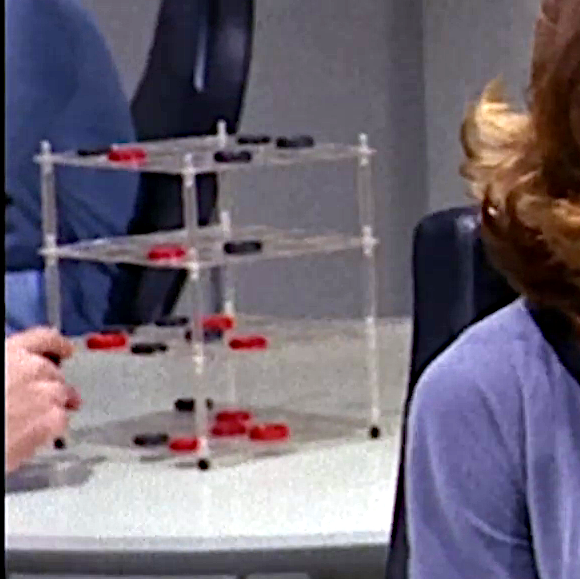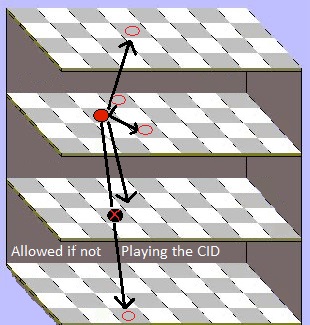Quadlevel 3D Checkers (Draughts)
Star Trek TOS 1966 Episode 'Alternative Factor' |  |
Only that the 3-Dimensional designs depicted on the show in the late 60s inspired the creation of the QuadLevel games.
Set up the Board - (Requires 2 sets of checkers) – 4x8x4 Board
A checker is placed on every black square in the first three columns.

The Change In Distance rule
You can play with the CID, or not. In practice it is not nearly as important, as in Quadlevel Chess. It is important to consider that in regular checkers, when a checker moves it changes distance between one player and his opponent. A checker moves forward or a King may move backward. To put it another way: If a piece started on the (A) rank he must stay on the (A) rank when changing boards. A Checker must change distance between one player’s side and the opponents side. The importance is not as strong in checkers, because it does not change the power between pieces, and it expands your capturing abitility. You may wish to enable Non-CID capturing, but not for checker-moving. A few interesting variants are possible. You might be able to setup a mind-blowing 8-checker capturing move, with the CID turned off. A word of caution: One of the things that happens in Checkers, is that one opponent tries to block all possible moves of the other. If you allow moves that do not advance or retreat, this may have game extending consequences, or even end in a draw, because the opponent may keep finding ways to escape. See the checkers youtube

The Moves
Checkers can move only one square forward in four different directions. Diagonally to the right, left, up one board, or down one board. If a checker is at c2 Level2 then it can move to d3 Level2, b3 Level2, c3 Level1, or c3 Level3.
Capturing
The player must capture if legal. As in regular Checkers, you may always play a variant, that does not force capture. Checkers can capture the opponent by jumping his piece diagonally. Again in four different directions, or more without the CID. The opposing checker is removed and the player lands at the next diagonally square or board, only if vacant. He can and has to if able to continue capturing if legal. In fact he may be able to capture all of the opponents checkers in one move.
Example using diagram of boards above. If a checker is at a3 Level1. If an opposing checker moves to a4 Level 2 and a5 level3 is vacant, he must capture by moving the a3 checker to a5 Level3 and the a4 Level2 opposing checker is removed. See the example of a triple capture in the diagram below.

King
When you get your checker to the eighth rank or the end of the board, you then can promote it to a King. This is usually represented by two checkers stacked on top of one another. This is a very powerful piece because now it can go backwards or all eight directions. If you were capturing and ended up on the last or eighth rank you can continue if legal to capture checkers backwards.
Object / Win
The object is to capture or block all of your opponents pieces.
Summary of Variants: (Watch the Youtube Video)
Normal (original): CID always enforced, and you must capture.
Fun (give this a try!): CID Enfored for movement, but capture
on side diagonals.
NoCID Free for all.
No Forced Capture (combine with other variants) (However usually for
beginner checker players)

What could the End-Game be like?
Imagine a scenario with 2-Kings vs 1-King ending. It seems in this game (it doesn't matter the variant...), the opponent could run out the 40-move clock into a Draw. It seems you need 3-Kings in that scenario to win. The 3rd dimension gives the opponent running room, that you just can't cover. As long as he stays toward the center, when your trying to corner him.